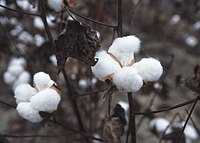
Photo from wikipedia
In phenotypically heterogeneous microbial populations, the decision to adopt one or another phenotype is often stochastically regulated. However, how this stochasticity affects interactions between competing microbes in mixed communities is… Click to show full abstract
In phenotypically heterogeneous microbial populations, the decision to adopt one or another phenotype is often stochastically regulated. However, how this stochasticity affects interactions between competing microbes in mixed communities is difficult to assess. One example of such an interaction system is the competition of an Escherichia coli strain C, which performs division of labor between reproducers and self-sacrificing toxin producers, with a toxin-sensitive strain S. The decision between reproduction or toxin production within a single C cell is inherently stochastic. Here, combining experimental and theoretical approaches, we demonstrate that this stochasticity in the initial phase of colony formation is the crucial determinant for the competition outcome. In the initial phase (t < 12h), stochasticity influences the formation of viable C clusters at the colony edge. In the subsequent phase, the effective fitness differences (set primarily by the degree of division of labor in the C strain population) dictate the deterministic population dynamics and consequently competition outcome. In particular, we observe that competitive success of the C strain is only found if (i) a C edge cluster has formed at the end of the initial competition phase and (ii) the beneficial and detrimental effects of toxin production are balanced, which is the case at intermediate toxin producer fractions. Our findings highlight the importance of stochastic processes during the initial phase of colony formation, which might be highly relevant for other microbial community interactions in which the random choice between phenotypes can have long-lasting consequences for community fate.
Journal Title: PLoS Biology
Year Published: 2017
Link to full text (if available)
Share on Social Media: Sign Up to like & get
recommendations!